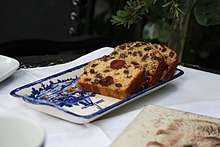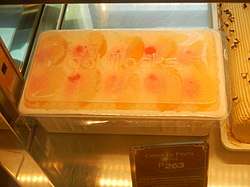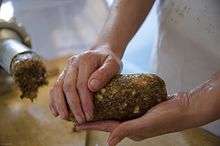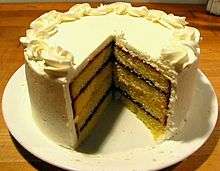Fruitcake
Fruitcake (or fruit cake or fruit bread) is a cake made with candied or dried fruit, nuts, and spices, and optionally soaked in spirits. In the United Kingdom, certain rich versions may be iced and decorated.
 A traditional English Fruitcake | |
| Type | Cake |
|---|---|
| Place of origin | Global |
| Region or state | Various |
| Created by | Originally from Roman times |
| Main ingredients | Candied fruit and/or dried fruit, nuts, spices, sugars, flour |
| Variations | Iced fruitcake, diabetic fruitcake, gluten-free fruitcake, lactose-free fruitcake |
Fruitcakes are typically served in celebration of weddings and Christmas. Given their rich nature, fruitcakes are most often consumed on their own, as opposed to with condiments (such as butter or cream).[1]
History
.jpg)
The earliest recipe from ancient Rome lists pomegranate seeds, pine nuts, and raisins that were mixed into barley mash. In the Middle Ages, honey, spices, and preserved fruits were added.
Fruitcakes soon proliferated all over Europe. Recipes varied greatly in different countries throughout the ages, depending on the available ingredients as well as (in some instances) church regulations forbidding the use of butter, regarding the observance of fast. Pope Innocent VIII (1432–1492) finally granted the use of butter, in a written permission known as the ‘Butter Letter' or Butterbrief in 1490, giving permission to Saxony to use milk and butter in the Stollen fruitcakes.[2]
Starting in the 16th century, sugar from the American Colonies (and the discovery that high concentrations of sugar could preserve fruits) created an excess of candied fruit, thus making fruitcakes more affordable and popular.[3]
In various countries
Australia
In Australia, fruitcake is consumed throughout the year, and is available at most major retail outlets. The cake is rarely eaten with icing or condiments.
Bahamas
In the Bahamas, not only is the fruitcake drenched with rum, but the ingredients are as well. All of the candied fruits, walnuts, and raisins are placed in an enclosed container and are soaked with the darkest variety of rum, anywhere from 2 weeks to 3 months in advance. The cake ingredients are mixed, and once the cake has finished baking, rum is poured onto it while it is still hot.
Bulgaria
In Bulgaria, the common fruitcake is known as keks (Bulgarian: кекс [kɛks]), is home-made and is consumed throughout the year. Recipes for keks vary, but commonly it contains flour, butter and/or cooking oil, milk, yeast, yoghurt, eggs, cocoa, walnuts, and raisins. It is usually baked in Bundt-style pan.
There is also another specific type of fruitcake prepared for Easter, which is known as kozunak (Bulgarian: козунак [kozoˈnak]).
Canada
The fruitcake is commonly eaten during the Christmas season in Canada. Rarely is it seen during other times of the year. The Canadian fruitcake is similar in style to the UK version, as it is in most Commonwealth countries. However, there is rarely icing on the cake and alcohol is not commonly put in Christmas cakes that are sold. The cakes also tend to be devoid of any decorations and are shaped like a small loaf of bread.
Dark, moist and rich Christmas fruitcakes are the most frequently consumed, with white Christmas fruitcake rarely seen. These cakes tend to be made in mid-November to early December when the weather starts to cool down. They are a staple during Christmas dinner and a gift generally exchanged between business associates and close friends/family.
Chile
This fruitcake is known as pan de pascua. To learn more, go to Pan de Pascua.
France
In France, as in some other non-English speaking countries, the gâteau aux fruits ("fruit-cake") is often simply called "Cake".
Germany
In Germany, baked goods that fit the description of fruitcake are not usually regarded as cake but rather as sweet breads.
Stollen is loaf-shaped and often powdered with icing sugar on the outside. It is usually made with yeast, butter, water, and flour, with the addition of citrus zest, candied citrus peel, raisins, and almonds.
The most famous Stollen is the Dresdner Stollen,[4] sold at the Dresden Christmas market, the Striezelmarkt. Official Dresden Stollen, produced by only 150 Dresden bakers, bears a special seal depicting Elector Augustus II the Strong.
In Bremen, the local fruitcake called Klaben is traditionally sold and eaten during the Christmas season. Bremer Klaben is a kind of Stollen which is not dusted with powdered sugar after baking. Both Dresdner Stollen and Bremen Klaben are protected geographical indications.
In Southern Germany and the Alpine region, Früchtebrot is a sweet, dark bread baked with nuts and dried fruit, e.g. apricots, figs, dates, plums.
India
Fruitcake is a rich dense cake packed with dry fruits and nuts flavoured with spices usually made during Christmas. In India, this is found everywhere during Christmas season, although it is also available commonly throughout the year.
Ireland
In Ireland, a type of fruitcake called barmbrack is eaten at Hallowe'en. The cake contains different objects such as a ring or small coin, each signifying a different fortune for the person who finds it.
Italy
Panforte is a chewy, dense Tuscan fruitcake dating back to 13th-century Siena. Panforte is strongly flavored with spices (Panforte means "Strong-bread") and baked in a shallow form. Genoa's fruitcake, a lower, denser but still crumbly variety, is called Pandolce ("Sweet-bread").
Panettone is a Milanese sweet bread loaf (widely available throughout Italy and in many other countries) served around Christmas which is traditionally filled with dried and candied fruits, with a bread loaf consistency similar in texture to Irish barm brack.
New Zealand
Fruitcakes arrived in New Zealand with early settlers from Britain. Until the 1960s fruitcake was generally homemade, but since then they have become commercially widely available in a range of styles. Light coloured fruitcake is often sold as tennis cake or light fruit-cake all year round.
Most New Zealand wedding cakes are finely iced and decorated fruitcake often several tiers high. Most fruitcake is eaten in the Christmas period. It is dark, rich and made from multiple dried fruit. Homemade cakes may use brandy or sherry to enhance flavour rather than as a preservative. They may be square or round, iced or uniced. A Christmas cake is usually simply decorated with a Christmas scene or the words Merry Christmas.
Philippines

In addition to the European-style fruitcake, a traditional fruitcake commonly eaten during Christmas in the Philippines is the crema de fruta. It is made with layers of sponge cake, sweet custard or whipped cream, gelatin or gulaman (agar), and various preserved or fresh fruits, including mangoes, pineapples, cherries, and strawberries.[5][6]
Easier-to-prepare icebox cake variants of crema de fruta use ladyfingers (broas) instead of sponge cake layers. Mango float is a very popular modern adaptation of this dish. It uses graham crackers and ripe carabao mangoes (though other fruits can be used as well).[7][8]
Poland
Keks is a traditional fruitcake eaten during Christmas season. It is a loaf shaped sponge cake with a substantial content of nuts, raisins, figs and candied fruits.
Portugal
Although French in its origin, Bolo Rei is a traditional fruitcake enjoyed during Christmas season and a staple dessert in any Portuguese home during the holidays. Included is the characteristic fava bean and, according to tradition, whoever finds the fava bean has to pay for the cake next year.
Spain

Bollo de higo is a cake made from figs, almonds or walnuts, and flavorings, similar to a panforte.
Switzerland
Birnenbrot[9] is a dense sweet Swiss fruitcake with candied fruits and nuts.
Anglophone Caribbean
Called black cake, is a traditional part of Christmas celebration in the English Caribbean. The cake incorporates a large quantity of mixed fruits and rum/wine and becomes a treasured Christmas treat consumed and given out between the Christmas season and New Years'. The fruit, wine and rum is prepared weeks sometimes months ahead, and has its origin in the English Christmas pudding, and can be quite expensive. It is very different from a North American fruitcake. In Guyana, South America, the same cake with icing, as in the U.K becomes a wedding cake.
United Kingdom
In the UK, fruitcakes come in many varieties, from extremely light to rich and moist.
The traditional Christmas cake is a round fruitcake covered in marzipan and then in white royal icing or fondant icing. They are often further decorated with snow scenes, holly leaves, and berries (real or artificial), or tiny decorative robins or snowmen. It is also the tradition for this kind of cake to be served at weddings as part of the dessert course.
In Yorkshire, it is often served accompanied with cheese. Fruitcakes in the United Kingdom often contain currants and glace cherries, an example of this type being the Genoa cake. One type of cake that originated in Scotland is the Dundee Cake, a type of fruitcake which does not contain glace cherries. This is a fruitcake that is decorated with almonds, and which owes its name to Keiller's marmalade.
Fruitcake was historically referred to as plum cake in England since around 1700.[10]
United States

Typical American fruitcakes are rich in fruit and nuts.
Mail-order fruitcakes in America began in 1913. Some well-known American bakers of fruitcake include Collin Street Bakery in Corsicana, Texas, and The Claxton Bakery in Claxton, Georgia. Both Collin Street and Claxton are Southern companies with inexpensive access to large nut quantities, for which the expression "nutty as a fruitcake" was derived in 1935.[3] Commercial fruitcakes are often sold from catalogs by charities as a fund raiser.
Most American mass-produced fruitcakes are alcohol-free, but traditional recipes are saturated with liqueurs or brandy and covered in powdered sugar, both of which prevent mold. Brandy (or wine) soaked linens can be used to store the fruitcakes, and some people feel that fruitcakes improve with age.
In the United States, the fruitcake has become a ridiculed dessert, in part due to the mass-produced inexpensive cakes of questionable age. Some attribute the beginning of this trend with The Tonight Show host Johnny Carson.[3] He would joke that there really is only one fruitcake in the world, passed from family to family. After Carson's death, the tradition continued with "The Fruitcake Lady" (Marie Rudisill), who made appearances on the show and offered her "fruitcake" opinions. In fact, the fruitcake had been a butt of jokes on television programs such as Father Knows Best and The Donna Reed Show years before The Tonight Show debuted and appears to have first become a vilified confection in the early 20th century, as evidenced by Warner Brothers cartoons.
It is not unusual for the residents of Parma, Ohio to exchange fruitcakes as a sign of affection during non-traditional times of year. This non-seasonal exchange is to take place on boxing day, Valentines Day, Fathers Day and The Fourth of July. Curiously none of the town's bakeries make fruitcake during the non Christmas season.
Since 1995, Manitou Springs, Colorado, has hosted the Great Fruitcake Toss on the first Saturday of every January. "We encourage the use of recycled fruitcakes," says Leslie Lewis of the Manitou Springs Chamber of Commerce. The all-time Great Fruitcake Toss record is 1,420 feet, set in January 2007 by a group of eight Boeing engineers who built the "Omega 380," a mock artillery piece fueled by compressed air pumped by an exercise bike.[11]
Shelf life
When a fruitcake contains a good deal of alcohol, it can remain edible for many years. For example, a fruitcake baked in 1878 was kept as an heirloom by a family (Morgan L. Ford) in Tecumseh, Michigan.[12] In 2003 it was sampled by Jay Leno on The Tonight Show. Wrapping the cake in alcohol-soaked linen before storing is one method of lengthening its shelf life.[13]
A 106-year-old fruitcake discovered in 2017 by the Antarctic Heritage Trust was described as in "excellent condition" and "almost" edible.[14]
See also
References
- Rowan, Terry. "Having a Wonderful Christmas Time Film Guide". Retrieved June 12, 2015.
- Stollen history
- Robert Sietsema. "A Short History of Fruitcake", The Village Voice, November 20–26, 2002.
- Meyers Lexikon Archived 2009-12-31 at the Wayback Machine: "Besonders bekannt ist der Dresdner Stollen" ("the Dresden Stollen is especially well-known")
- Lalaine (28 November 2017). "Crema de Fruta". Kawaling Pinoy. Retrieved 2 December 2018.
- "Crema de Fruta Recipe". Panlasang Pinoy. 2009-07-22. Retrieved 2 December 2018.
- Jane (5 December 2016). "Crema de Fruita a Festive Christmas Dessert". Maputing Cooking. Retrieved 2 December 2018.
- Maryanne (15 June 2017). "Mango Royale (Mango Icebox Cake)". The Little Epicurean. Retrieved 2 December 2018.
- Swiss recipes, Grandma´s Birnenbrot Archived 2009-04-12 at the Wayback Machine
- Goldstein, D.; Mintz, S.; Krondl, M.; Rath, E.; Mason, L.; Quinzio, G.; Heinzelmann, U. (2015). The Oxford Companion to Sugar and Sweets. Oxford University Press. p. 120. ISBN 978-0-19-931339-6.
- Photos from the 2009 event: www.blueskiesbb.com/fruitcake-popup.html
- "Holidays—and Centuries—Come and Go, but for the Faithful Fords, It's Semper Fidelia's Fruitcake". People Magazine. November 30, 1987. Retrieved April 9, 2016.
- Mac, Scotty (December 21, 2010). "Fruitcakes – Myths, Mysteries and Truths". Scotty Mac's Blog. Archived from the original on March 8, 2012. Retrieved April 9, 2016 – via Internet Archive Wayback Machine.CS1 maint: unfit url (link)
- "Fruitcake From Robert Scott Expedition Is 'Almost' Edible at 106 Years Old". New York Times. August 15, 2017. Retrieved August 14, 2017.
.jpg)
